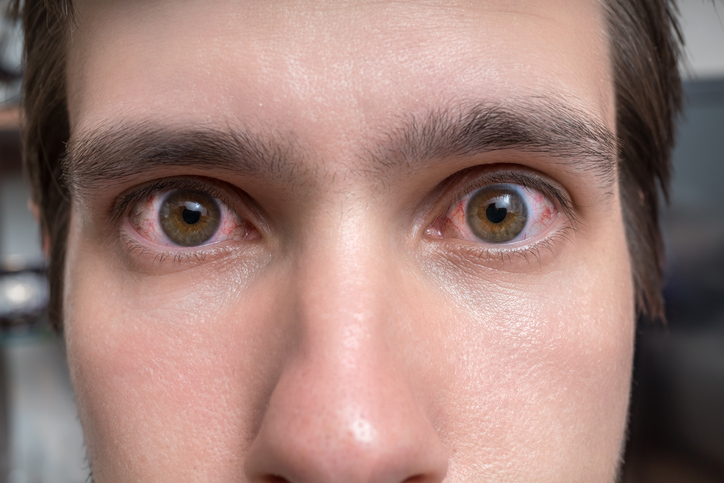Symptoms and treatment of Graves’ disease
We need to know more about Graves’ disease: Graves’ disease happens to be an autoimmune disease of the thyroid that results from abnormal stimulation of the thyroid gland by a material in the blood that is usually referred to as thyroid stimulating immunoglobins (TSIs) that bind to and activate thyrotropin receptors.
What there is to know more about it?
Graves’ disease is indeed the most common cause of hyperthyroidism in the U.S.
Signs and symptoms of Graves’ disease do include
- diffuse thyrotoxic goiter,
- problems getting pregnant,
- lighter menstrual flow and less frequent periods,
- weight loss,
- frequent bowel movements,
- increased heart rate and heart palpitations,
- thinning hair,
- heat insensitivity
- brittle hair,
- hand tremors,
- problems sleeping,
- increased sweating,
- eye problems (ophthalmopathy, exophthalmos), and
- Become red and thickening of the skin on the shins and top of one’s feet (pretibial myxedema or thyroid dermopathy).
- The cause of Graves’ disease is thought to be related to many factors that include genetic, gender, stress, pregnancy, and even infections.
- Graves’ disease does affect both men and women; however, the autoimmune thyroid disease does affect women about eight to 10 times more often than men.
- Risk factors for Graves’ disease are associated with other autoimmune diseases such as vitiligo, rheumatoid arthritis, pernicious anemia, Addison’s disease, type 1 diabetes, and lupus.
- Tests to diagnose Graves’ disease include thyroid function tests, radioactive iodine uptake tests, and tests to detect TSIs.
- Treatments for Graves’ disease include radioactive iodine, antithyroid drugs such as methimazole (Tapazole) and propylthiouracil (PTU), and beta blockers; in some patients, surgery is done.
- Untreated Graves’ disease can indeed lead to thyrotoxicosis and its severe form, thyroid storm, a life-threatening condition that does cause heart problems, weak and brittle bones as well as death.
- Poorly treated Graves’ disease during pregnancy can cause problems for the woman such as preterm birth, miscarriage, heart failure, preeclampsia, and placental abruption.
- Poorly treated Graves’ disease can cause health problems for a fetus or baby such as preterm birth, low birth weight, thyroid problems, and stillbirth.
Graves ‘disease and Hyperthyroidism Symptoms
Hyperthyroidism or rather an overactive thyroid is acknowledged as a condition whereby an excessive amount of thyroid hormones are indeed produced by the thyroid gland. A common cause of hyperthyroidism is Graves’ disease, which happens to be another type of thyroid problem that cannot be cured. If Graves’ disease is not treated one can die. (It is fatal.) Graves’ disease and hyperthyroidism share similar symptoms such as unexplained weight loss, trembling hands, heat intolerance, irritability, and frequent bowel movements.
What is Graves’ disease?
Graves’ disease is an autoimmune disorder that causes hyperthyroidism or overactive thyroid. With this disease, one’s immune system attacks the thyroid and thus causes it to make more thyroid hormone than one’s body requires. The thyroid is a small, butterfly-shaped gland in the front of one’s neck. Thyroid hormones control how one’s body uses energy, so they affect nearly every organ in our body – even the way one’s heart beats.
If left untreated, hyperthyroidism can indeed cause serious problems with the heart, bones, muscles, menstrual cycle, and fertility. During pregnancy, untreated hyperthyroidism can also lead to health problems for the mother and baby. Graves’ disease also can affect one’s eyes and skin.
What are the signs and symptoms of Graves’ disease?
It is suffering from Graves’ disease, the symptoms one faces are:
• fast and irregular heartbeat
• frequent bowel movements or diarrhea
• goiter
• heat intolerance
• nervousness or irritability
• tiredness or muscle weakness
• trembling hands
• trouble sleeping
• weight loss
People with Graves’ disease do develop a reddish thickening of the skin on the shins, a condition that is referred to as pretibial myxedema or Graves’ dermopathy. This skin problem is generally painless and mild, but it can also cause much pain to some.
Graves’ ophthalmopathy (Graves’ orbitopathy) can also cause retracted eyelids, in other words, the eyelids are pulled back from the eye. Graves’ orbitopathy can also cause bulging eyes, double vision, and swelling around the eyes.
What causes Graves’ disease?
Researchers are not actually very sure why some people do develop autoimmune disorders such as Graves’ disease. These disorders do probably develop from a combination of genes and an outside trigger, such as a virus.
With Graves’ disease, the immune system does make an antibody called thyroid-stimulating immunoglobulin (TSI) that does also get attached to thyroid cells. TSI does act like thyroid-stimulating hormone (TSH), a hormone made in the pituitary gland that does tell the thyroid how much thyroid hormone to take. TSI does cause the thyroid to make too much thyroid hormone.
Is Graves’ disease a problem during pregnancy?
Thyroid hormone levels which may be high a bit usually are not a problem in pregnancy. However, more severe hyperthyroidism that is not treated can indeed affect both the mother and the baby as well. The hyperthyroidism is indeed under control before becoming pregnant.
Who gets Graves’ disease? Is it common?
Graves’ disease is indeed the most common cause of hyperthyroidism in the United States. The disease does affect about 1 in 200 people.
Graves’ disease usually affects people between ages 30 and 50, but can also occur at any age. The disease is seven to eight times more common among women than men. Hereditary does play a role in getting the disease.
People with other autoimmune disorders are more likely to develop Graves’ disease than people without these disorders. Conditions linked with Graves’ disease include:
- rheumatoid arthritis, a disorder that affects the joints and sometimes other body systems
- pernicious anemia, a condition caused by a vitamin B12 deficiency
- lupus, a chronic, long-term disorder that can affect many parts of your body
- Addison’s disease, a hormonal disorder
- celiac disease, a digestive disorder
- vitiligo, a disorder in which some parts of the skin are not pigmented
- type 1 diabetes
What tests diagnose Graves’ disease?
The health care provider may indeed suspect Graves’ disease based on one’s symptoms and findings during a physical exam. One or more blood tests can rather confirm that one has hyperthyroidism and may point to Graves’ disease as the cause.
Other clues that hyperthyroidism is caused by Graves’ disease are:
- an enlarged thyroid
- signs of Graves’ eye disease, present in about one out of three people who are suffering from Graves’ disease
- a history of other family members with thyroid or autoimmune problems
- In case of uncertain diagnosis is uncertain, one’s doctor may order further blood or imaging tests to confirm Graves’ disease as the cause.
- A blood test can detect TSI: However, in mild cases of Graves’ disease, TSI may not show up in your blood. The next step may be one of two imaging tests that use small, safe doses of radioactive iodine. Your thyroid collects iodine from one’s bloodstream and makes use of to make thyroid hormones; it will collect radioactive iodine in the same way.
- Radioactive iodine uptake test: This test measures the amount of iodine the thyroid tends to collect from the bloodstream. If one’s thyroid collects large amounts of iodine, one may have Graves’ disease.
- Thyroid scan: This scan does indicate how and where iodine is distributed in the thyroid. With Graves’ disease, the entire thyroid is involved, so the iodine does show up throughout the gland.
What is the treatment for Graves’ disease? Can it be cured?
One has three treatment options: medicine, radioiodine therapy, and thyroid surgery. Radioiodine therapy is indeed the most common treatment for Graves’ disease in the United States, but doctors are beginning to make use of medicine more often than in the past. Based on factors such as one’s age, whether one is pregnant, or whether one has other medical conditions, one’s doctor may be able to recommend a specific treatment and can help one to decide which one is right for oneself.
Radioiodine therapy for Graves’ disease
For radioiodine therapy, one has to take radioactive iodine-131 (I-131) by mouth as a capsule or liquid. I-131, at a higher dose than the dose used for imaging tests that slowly destroys the cells of the thyroid gland that does produce thyroid hormone. The dose of I-131 usually is made use of for radioiodine therapy which does not affect other body tissues. One can take radioactive iodine-131 as a capsule or liquid.
Treatment with medicines called beta blockers can also control one’s symptoms.
Almost everyone who has radioactive iodine treatment later does develop hypothyroidism, or underactive thyroid because the thyroid hormone-producing cells have been destroyed. However, hypothyroidism is easier to treat and causes fewer long-term health problems than hyperthyroidism. Those suffering from hypothyroidism can completely control the condition with daily thyroid hormone medicine.
Doctors do not make use of radioiodine therapy in order to treat pregnant women or women who are breastfeeding. Radioactive iodine can indeed harm the fetus’ thyroid and can also be passed from mother to child in breast milk.
Beta-blockers
Beta blockers do not stop one’s thyroid from producing thyroid hormone but can indeed reduce symptoms until other treatments take effect. These medicines do act quickly in order to relieve many of the symptoms of hyperthyroidism, such as trembling, rapid heartbeat, and nervousness. Most people do feel better within hours of taking beta blockers.
Antithyroid medications
Antithyroid therapy is the simplest way to treat hyperthyroidism. Antithyroid medicines can cause one’s thyroid to make less thyroid hormone. These medicines do usually do not provide a permanent cure, but in some people, the effects do last a long time after they stop taking the medicine. Doctors most often make use of the antithyroid medicine methimazole.
Doctors usually do treat pregnant and breastfeeding women with antithyroid medicine, since this treatment may be safer for the baby than other treatments. Doctors make use of propylthiouracil more often than methimazole during the first 3 months of pregnancy because methimazole that may harm the fetus, although this does happen rarely. Also rarely, propylthiouracil does affect the fetus, but any effects are less harmful than having uncontrolled hyperthyroidism during pregnancy.
Once treatment with antithyroid medicine does begin, one’s thyroid hormone levels may not move into the normal range for several weeks or months. The total average treatment time taken is about 12 to 18 months, but treatment can continue for several years in case one does not want radioiodine or surgery to treat their Graves’ disease.
Surgery for Graves’ disease
This not much used treatment for Graves’ disease to remove the thyroid gland. At times doctors make use of surgery to treat people with large goiters, or pregnant women who are allergic to or have side effects from anti thyroid medicines.
After surgery to remove one’s thyroid, one will also develop hypothyroidism and one needs to take thyroid hormone medicine every day for life. After surgery, the doctor will continue to check one’s thyroid hormone levels and also adjust the dose as per requirement.
Homeopathy Treatment for Graves’ disease
Homeopathy provides exceptional treatment for Graves’ disease. Homeopathic medicines safely and surely provide relief from the symptoms of Graves’ disease. At Dr Ankireddy, We provide Best Homeopathic treatment in Hyderabad for Graves’ disease based on their symptoms and treated with well experienced homeopathic. Consult our homeopathic doctors in Hyderabad for safe, painless, and natural healing treatments.









There are no comments